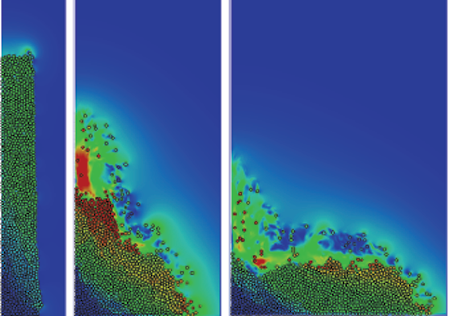Model of Tumbling Sand Castles
Underwater avalanches can generate deadly tsunamis and damage oil platforms. But understanding the threat has been difficult because of the complexities of water-grain mixtures. A new two-dimensional model simulates the collapse of a tower of grains immersed in a fluid by computing the forces on each grain from the fluid and from other grains. The results—presented in Physical Review Letters—show that the presence of the fluid has two conflicting effects: it restrains the collapse but then lubricates the grains as they tumble outwards. The model may one day help in predicting risk in underwater environments as well as optimizing wet processing techniques used in the food and steel industries.
In 1929, a seafloor avalanche triggered by an earthquake off the coast of Newfoundland swept debris out over 400 miles, snapping 12 transatlantic telegraph cables along its path. Such a long “runout” distance is common in submarine landslides. But the explanation for the long runout is unclear because researchers have focused more on “dry” avalanches and landslides. Wet grains are harder to model, since the fluid can restrain grain motion through cohesion and drag, while also helping the grains slide past each other. Previous studies have often simplified the wet-grain problem by adding a small number of grains (or some granular effects) to a fluid flow, or by adding some fluid effects to a granular flow. However, many grain-fluid mixtures in underwater environments and industrial situations have nearly equal parts solid and liquid.
Farhang Radjaï of the University of Montpellier 2 in France and his colleagues have developed a computational model of granular flows in a fluid environment. As in similar work with dry grains, they concentrate on a specific situation in which a tower or column of grains falls under the influence of gravity [1]. The team divided this collapse into discrete time steps at which they calculated the forces on every grain and the overall motion of the fluid. The method builds on earlier simulations of dry grains [2] but now includes the fluid forces that act on the grains, such as pressure and cohesion. The simulation simultaneously keeps track of the fluid motion by solving the hydrodynamic (Navier-Stokes) equations, with the grains providing a time-varying “container.”
Coupling the grain and fluid motion together is computationally intense, so the team has reduced the problem to two dimensions. Radjaï says this is justified because 2D models of dry grains have shown a close correspondence with 3D experiments. The grains in this case are modeled as millimeter-sized disks that are initially stacked against a wall in a rectangular column. This setup is unstable, so the grains immediately fall into a heap that spills out away from the wall (see movies).
The team observed the collapse for different aspect ratios (height vs width) of the column while also exploring three options for the surrounding medium: no fluid, water, and a viscous fluid. The runout distances were similar for the no-fluid and water cases, which was surprising, since the no-fluid collapse took less than half the time as both fluid cases. The team explained this by calculating the average kinetic energy in the grains. When the fluid is present, the grains lose some of their gravitational potential energy to fluid motion. However, the fluid later helps to keep the outward horizontal flow moving by reducing friction forces on the grains. “The fluid gives back most of the energy it took,” Radjaï says.
The team plans to extend their simulations into three dimensions and to study wave formation in the fluid flow. The work could help researchers assess the risk that underwater avalanches (and the tsunamis they generate) pose to offshore installations and coastal communities. Down the road, models like this one may benefit industrial methods for mixing liquid and granular ingredients in food processing and steel making.
The analysis is “quite nice and interesting for understanding the transfer of energy in the different regimes and the role played by the ambient fluid,” says Philippe Gondret from the University of Paris-Sud in Orsay, France. The work extends earlier efforts with dry particles by making it possible to simulate “a broad collection of solid particles immersed in a fluid,” Gondret says.
–Michael Schirber
Michael Schirber is a Corresponding Editor for Physics Magazine based in Lyon, France.
References
- L. Lacaze and R. R. Kerswell, “Axisymmetric Granular Collapse: A Transient 3D Flow Test of Viscoplasticity,” Phys. Rev. Lett. 102, 108305 (2009)
- F. Radjaï and V. Richefeu, “Contact Dynamics as a Nonsmooth Discrete Element Method,” Mech. Mater. 41, 715 (2009)





